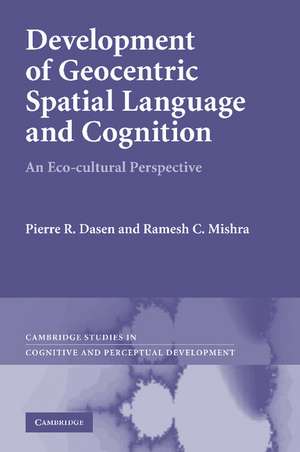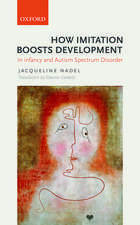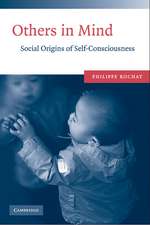Development of Geocentric Spatial Language and Cognition: An Eco-cultural Perspective: Cambridge Studies in Cognitive and Perceptual Development, cartea 12
Autor Pierre R. Dasen, Ramesh C. Mishraen Limba Engleză Paperback – 2 ian 2013
| Toate formatele și edițiile | Preț | Express |
|---|---|---|
| Paperback (1) | 323.05 lei 43-57 zile | |
| Cambridge University Press – 2 ian 2013 | 323.05 lei 43-57 zile | |
| Hardback (1) | 787.78 lei 43-57 zile | |
| Cambridge University Press – 11 aug 2010 | 787.78 lei 43-57 zile |
Din seria Cambridge Studies in Cognitive and Perceptual Development
-
 Preț: 285.75 lei
Preț: 285.75 lei -
 Preț: 287.48 lei
Preț: 287.48 lei -
 Preț: 324.03 lei
Preț: 324.03 lei - 14%
 Preț: 785.17 lei
Preț: 785.17 lei -
 Preț: 316.52 lei
Preț: 316.52 lei -
 Preț: 400.76 lei
Preț: 400.76 lei -
 Preț: 279.17 lei
Preț: 279.17 lei -
 Preț: 196.96 lei
Preț: 196.96 lei -
 Preț: 353.87 lei
Preț: 353.87 lei -
 Preț: 385.61 lei
Preț: 385.61 lei -
 Preț: 327.68 lei
Preț: 327.68 lei -
 Preț: 287.07 lei
Preț: 287.07 lei
Preț: 323.05 lei
Nou
Puncte Express: 485
Preț estimativ în valută:
61.82€ • 64.15$ • 51.67£
61.82€ • 64.15$ • 51.67£
Carte tipărită la comandă
Livrare economică 17-31 martie
Preluare comenzi: 021 569.72.76
Specificații
ISBN-13: 9781107412484
ISBN-10: 110741248X
Pagini: 410
Dimensiuni: 152 x 229 x 21 mm
Greutate: 0.54 kg
Editura: Cambridge University Press
Colecția Cambridge University Press
Seria Cambridge Studies in Cognitive and Perceptual Development
Locul publicării:New York, United States
ISBN-10: 110741248X
Pagini: 410
Dimensiuni: 152 x 229 x 21 mm
Greutate: 0.54 kg
Editura: Cambridge University Press
Colecția Cambridge University Press
Seria Cambridge Studies in Cognitive and Perceptual Development
Locul publicării:New York, United States
Cuprins
Part I. Introduction and Methods: 1. Theory and research questions; 2. Methods; 3. Settings; Part II. Results: 4. Pilot study in Bali and first study (India and Nepal, 1999–2000); 5. Returning to Bali: main study 2002–7; 6. Varanasi; 7. Kathmandu; 8. Panditpur; 9. Geneva; Part III. Additional Studies: 10. Spatial language addressed to children; 11. Geocentric gestures before language?; 12. Spatial organization schemes; 13. Neurophysiological correlates of geocentric space; 14. Geocentric dead reckoning; Part IV. Conclusions: 15. Discussion and conclusions; Appendix 1. Summary of instructions, questionnaires, and coding schemes; Appendix 2. Examples of language in each location; Appendix 3. Extracts from school manuals.
Recenzii
'A remarkable illustration of how research can integrate concepts, methods and findings from cognitive and developmental psychology, as well as from cultural anthropology and linguistics, to explain the development and use of spatial frames of reference in a number of cultures.' John W. Berry, Queen's University, Canada
'A wonderful contribution to the literature on child development in relation to language and culture.' Penelope Brown, Max Planck Institute for Psycholinguistics
'Dasen and Mishra invite us to revisit the concept of spatial knowledge from a radically decentered perspective. From Bali through India to Nepal, they treat us to a fascinating journey into a variety of cultures. This book offers a richly documented, refreshing alternative to the Western view of human spatial cognition and language.' Michel Denis, LIMSI-CNRS, National Center for Scientific Research, Orsay
'A wonderful contribution to the literature on child development in relation to language and culture.' Penelope Brown, Max Planck Institute for Psycholinguistics
'Dasen and Mishra invite us to revisit the concept of spatial knowledge from a radically decentered perspective. From Bali through India to Nepal, they treat us to a fascinating journey into a variety of cultures. This book offers a richly documented, refreshing alternative to the Western view of human spatial cognition and language.' Michel Denis, LIMSI-CNRS, National Center for Scientific Research, Orsay
Descriere
Investigates the acquisition and use of geocentric spatial language for children in Bali, India, Nepal, and Switzerland.













